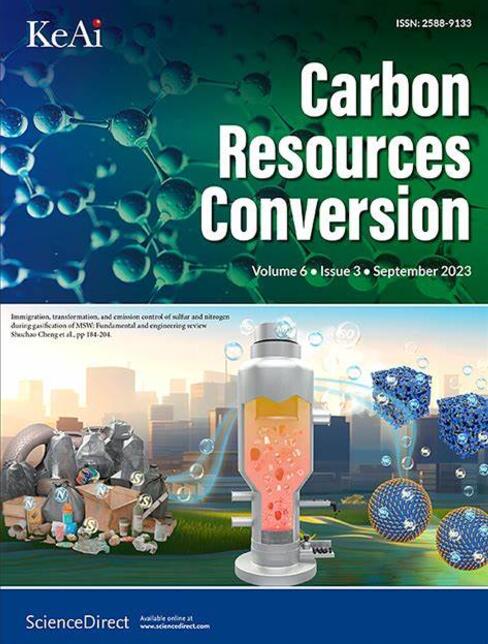Microwaved-induced co-pyrolysis of used engine lubricant and palm empty fruit bunch for alternative fuel recovery
IF 7.5
3区 环境科学与生态学
Q2 ENERGY & FUELS
引用次数: 0
Abstract
Alternative fuel recovery from used engine lubricant (UEL) and empty fruit bunch (EFB) was achieved through microwave co-pyrolysis. Co-pyrolysis was chosen for its potential to improve the quality of pyrolytic oil by generating synergistic effects between two distinct feedstocks, reducing activation energy, and enhancing pyrolytic oil quality. The central composite design (CCD) of response surface methodology (RSM) was used to optimise the temperature and EFB ratio. Atomic absorption spectrometry (AAS) was employed to characterise the heavy metal concentration in the pyrolytic oil. The optimised pyrolytic oil (UE450) produced the highest oil yield (25.17 wt%) with the lowest metal concentration at 450 °C with a 50 % EFB ratio. The fuel’s characteristics were similar to those of conventional diesel, with a higher value of HHV (45.17 MJ/kg). However, the oil was slightly acidic, with a pH of 4.3. GC–MS analysis of UE450 revealed the presence of alkanes and monoaromatic-rich hydrocarbons. Additionally, the UE450 biochar was characterised using FTIR, FESEM, and XRF. FTIR analysis showed that the carbonyl group (C = O) peaks at 1730 and 1440 cm−1 disappeared, indicating that heavy metals were bound to the biochar surface. Likewise, XRF analysis of UE450 biochar revealed that zinc (Zn) exhibited a high metal adsorption capacity, following the sequence Zn > Fe > Pb (1.96, 1.06, and 0.81 mmol/g). The XRF results also indicated a significant removal of SO3 at approximately 10.37 mmol/g.

微波诱导的废发动机润滑油和棕榈空果束共热解用于替代燃料回收
利用微波共热解技术,实现了废发动机润滑油(UEL)和空果束(EFB)的替代燃料回收。选择共热解,是因为它可以在两种不同的原料之间产生协同效应,降低活化能,提高热解油的质量。采用响应面法(RSM)的中心复合设计(CCD)优化温度和EFB比。采用原子吸收光谱法(AAS)测定了热解油中重金属的含量。优化后的热解油(UE450)在450°C和50%的EFB比下,以最低的金属浓度产生最高的油收率(25.17 wt%)。该燃料的特性与传统柴油相似,HHV值更高(45.17 MJ/kg)。然而,这种油呈微酸性,pH值为4.3。GC-MS分析显示UE450中存在烷烃和富单芳烃。此外,使用FTIR, FESEM和XRF对UE450生物炭进行了表征。FTIR分析表明,在1730和1440 cm−1处羰基(C = O)峰消失,表明重金属被吸附在生物炭表面。同样,对UE450生物炭的XRF分析显示,锌(Zn)具有较高的金属吸附能力,其顺序为Zn >;菲比;铅(1.96、1.06和0.81 mmol/g)。XRF结果还表明,SO3的去除率约为10.37 mmol/g。
本文章由计算机程序翻译,如有差异,请以英文原文为准。
求助全文
约1分钟内获得全文
求助全文
来源期刊

Carbon Resources Conversion
Materials Science-Materials Science (miscellaneous)
CiteScore
9.90
自引率
11.70%
发文量
36
审稿时长
10 weeks
期刊介绍:
Carbon Resources Conversion (CRC) publishes fundamental studies and industrial developments regarding relevant technologies aiming for the clean, efficient, value-added, and low-carbon utilization of carbon-containing resources as fuel for energy and as feedstock for materials or chemicals from, for example, fossil fuels, biomass, syngas, CO2, hydrocarbons, and organic wastes via physical, thermal, chemical, biological, and other technical methods. CRC also publishes scientific and engineering studies on resource characterization and pretreatment, carbon material innovation and production, clean technologies related to carbon resource conversion and utilization, and various process-supporting technologies, including on-line or off-line measurement and monitoring, modeling, simulations focused on safe and efficient process operation and control, and process and equipment optimization.
 求助内容:
求助内容: 应助结果提醒方式:
应助结果提醒方式:


